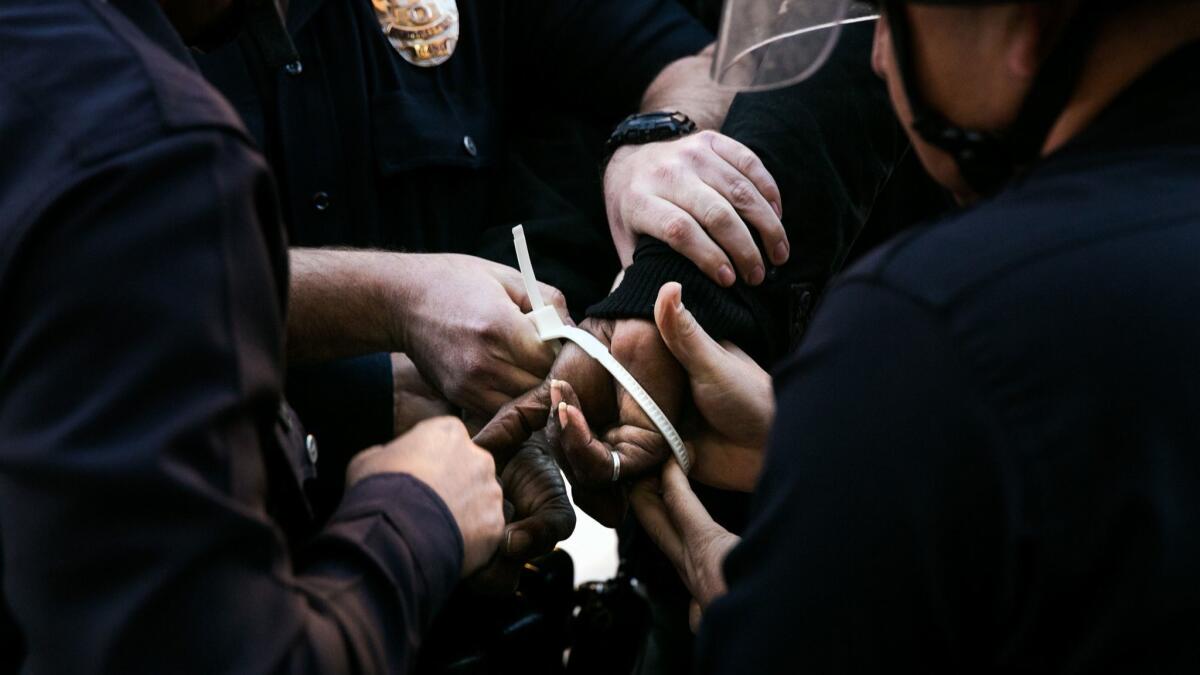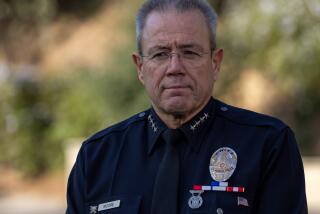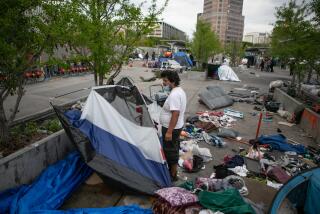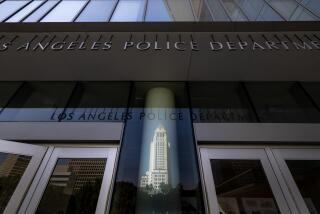LAPD inspector general raises concern over officers’ actions with people accused of resisting arrest

The homeless man refused to take down his tent, so the police officers decided to arrest him for resisting them.
As the situation grew increasingly tense, an officer used a Taser on the man, who wore only boxer shorts, even though he was not acting violently and was not likely to be concealing a weapon.
The incident, captured on police video, was described in a report by the Los Angeles Police Department’s inspector general that raises concerns about whether some Los Angeles police officers react too aggressively to people they perceive as uncooperative or disrespectful.
The report, presented to the Police Commission on Tuesday, examined more than 100 cases of people taken into custody and accused of resisting arrest.
In two-thirds of the cases, LAPD officers acted appropriately, Inspector General Mark P. Smith wrote.
But in the remaining third, the report found issues ranging from unnecessary use of a Taser, as in the homeless man’s case, to lack of legal cause for stopping someone.
In one instance, officers detained several juveniles for taking photos of themselves flashing gang signs, which was not a violation of the law. The officers also asked for their cellphones — a warrantless search that the report said was not justified.
In another instance, a man who was a possible victim of an assault became belligerent, then complied with an officer’s order to put his hands behind his back. When he failed to immediately comply with an order to get down on his knees, the officers wrestled him to the ground.
“Given the fact that the arrestee had generally been complying with the officers’ directions, it was not clear why the takedown was conducted or why more attempts at de-escalation did not occur,” the report said.
Officers sometimes used profanity or belittled people by calling them names or telling them to shut up or stop talking, according to the report, escalating minor incidents “by provoking frustration and protest on the part of the person being detained.”
The inspector general’s report focused on violations of California Penal Code Section 148(a)(1) — a misdemeanor covering conduct such as resisting an officer’s attempts at handcuffing, fleeing from officers or refusing to provide information while detained.
The report examined 132 arrests from June 2016 to March 2017 that were captured on in-car or body camera video — about 35% of the total Section 148 arrests during that period.
Nearly half the people arrested were African American in a city that is about 9% black. More than 40% of those arrested were Latino.
A quarter were homeless, 16% appeared mentally ill and 13% appeared to be under the influence of alcohol or drugs.
The LAPD divisions with the highest number of arrests were Southwest and 77th Street — both in predominantly black and Latino South Los Angeles neighborhoods.
The report noted that some residents refer to resisting arrest as “contempt of cop” because officers can use it against people for being mouthy or having a bad attitude. Officers can also potentially use the offense to provide a justification for unnecessary force, the report said.
Under the federal consent decree that imposed reforms on the LAPD from 2001 to 2013, bookings for resisting arrest received heightened scrutiny. Watch commanders are still charged with evaluating each arrest and recommending training or policy changes to remedy flaws.
In the report, slightly more than 20% of those arrested were initially stopped by police for quality-of-life issues such as drinking, loitering or homelessness. An additional 13% were stopped for “suspicious activity” and 28% for motor vehicle violations.
The city attorney’s office, which typically prosecutes misdemeanors, ultimately filed charges in only 35% of the cases.
Police Commissioner Shane Murphy Goldsmith said she has received complaints from residents about police officers’ handling of contentious situations.
“In addition to the concerns I have already mentioned about disparate impact and bias and particularly the impact on the homeless, it does touch on other issues in terms of important issues of procedural justice and legitimacy and trust — particularly trust in African American communities,” Goldsmith said. “We can see here that this is a clear area where we can improve.”
Melanie Ochoa, a staff attorney for the ACLU of Southern California, pointed to the low rate of prosecution and the high percentage of African Americans arrested. She called on the Police Commission — a five-member civilian board that oversees the LAPD — to cut down on both stops and arrests and to discipline officers who arrest people unnecessarily.
Police Chief Michel Moore noted that the vast majority of police encounters end with people voluntarily complying. He said he supported the report’s findings.
“Ensuring that our officers’ tone and their tenor in those engagements are constantly looking to de-escalate and find the ability to gain the willful compliance and cooperation even of an offender where this investigation may lead to their arrest and incarceration, is a point where I’m proud of the work our men and women do,” Moore said. “And where we may fall short, I see those as opportunities for us to improve.”
The inspector general’s report recommends that the LAPD provide additional training and work with the city attorney’s office to ensure that cases comply with legal standards. The report also recommends that the department examine officers’ use of Tasers so that the weapons are deployed only on people who are violent or pose an immediate threat.
Steve Gordon, a director of the Los Angeles Police Protective League, the union representing the LAPD’s rank and file, said in a statement that officers faced with a volatile situation sometimes speak loudly or “use salty language.”
“Viewing videotape from the safe confines of an office is a lot different than actually policing the dangerous streets of Los Angeles,” he said.
For more news on the Los Angeles Police Department, follow me on Twitter: @cindychangLA
UPDATES:
7:50 p.m.: This article was updated with additional information from the report and comments and was edited throughout.
This article was originally published at 12:10 p.m.
More to Read
Start your day right
Sign up for Essential California for news, features and recommendations from the L.A. Times and beyond in your inbox six days a week.
You may occasionally receive promotional content from the Los Angeles Times.







